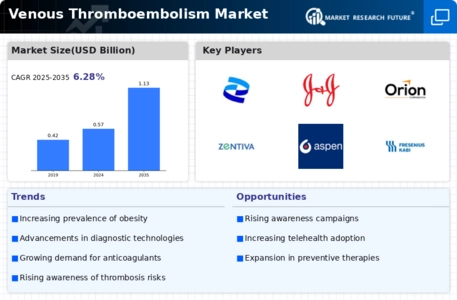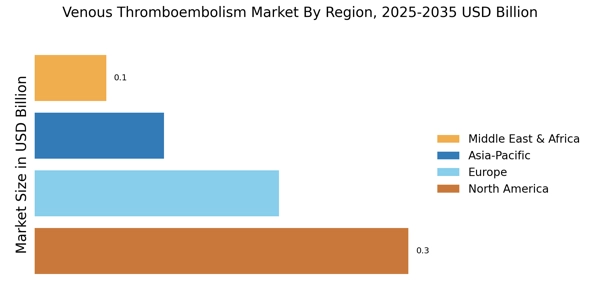Growing Geriatric Population
The growing geriatric population is a crucial factor driving the Venous Thromboembolism Market. As individuals age, the risk of developing VTE increases due to factors such as decreased mobility and the presence of comorbidities. Projections indicate that by 2030, the number of individuals aged 65 and older will surpass 1 billion, creating a substantial demand for VTE management solutions. This demographic shift necessitates the development of targeted therapies and preventive measures tailored to the needs of older adults. As healthcare systems adapt to this changing landscape, the Venous Thromboembolism Market is poised for growth, driven by the need for effective interventions that address the unique challenges faced by the aging population.
Increased Awareness and Education
The heightened awareness and education regarding venous thromboembolism are pivotal in shaping the Venous Thromboembolism Market. Campaigns aimed at educating both healthcare professionals and the general public about the risks and symptoms of VTE have led to earlier diagnosis and treatment. This increased awareness is crucial, as timely intervention can significantly reduce morbidity and mortality associated with VTE. Moreover, educational initiatives are likely to foster a culture of prevention, encouraging individuals to seek medical advice when experiencing risk factors. As awareness continues to grow, the Venous Thromboembolism Market is expected to expand, driven by the demand for educational resources and preventive strategies.
Advancements in Anticoagulant Therapies
Innovations in anticoagulant therapies are significantly influencing the Venous Thromboembolism Market. The introduction of novel oral anticoagulants (NOACs) has transformed the treatment landscape, offering patients more convenient options compared to traditional therapies. These advancements not only enhance patient compliance but also reduce the risk of complications associated with older anticoagulants. The market for anticoagulants is projected to grow, with estimates suggesting a compound annual growth rate (CAGR) of over 6% in the coming years. As healthcare professionals increasingly adopt these new therapies, the Venous Thromboembolism Market is likely to experience substantial growth, driven by the demand for safer and more effective treatment alternatives.
Rising Incidence of Venous Thromboembolism
The increasing incidence of venous thromboembolism (VTE) is a primary driver for the Venous Thromboembolism Market. Studies indicate that VTE affects approximately 1 in 1,000 individuals annually, with risk factors such as obesity, aging, and prolonged immobility contributing to this rise. As the population ages, the prevalence of conditions that predispose individuals to VTE is likely to escalate, thereby increasing the demand for effective treatment options. Furthermore, the awareness surrounding VTE has improved, leading to more diagnoses and treatment interventions. This growing recognition of VTE as a serious health concern is expected to propel the Venous Thromboembolism Market forward, as healthcare providers seek to implement preventive measures and therapeutic solutions to manage this condition.
Regulatory Support for Innovative Treatments
Regulatory support for innovative treatments is a significant driver of the Venous Thromboembolism Market. Regulatory agencies are increasingly fast-tracking the approval processes for new therapies, recognizing the urgent need for effective VTE management solutions. This supportive environment encourages pharmaceutical companies to invest in research and development, leading to the introduction of novel therapies that address unmet medical needs. The approval of new drugs and treatment modalities is likely to stimulate market growth, as healthcare providers gain access to a broader range of options for managing VTE. Consequently, the Venous Thromboembolism Market stands to benefit from this regulatory landscape, fostering innovation and improving patient outcomes.


















Leave a Comment